China has introduced new guidelines aimed at gradually eliminating US microprocessors from Intel and AMD, along with Microsoft’s Windows operating system, from government personal computers and servers, according to a report by the Financial Times. The procurement guidance also encourages the adoption of domestic alternatives for database software.
Government agencies at and above the township level are instructed to prioritize “safe and reliable” processors and operating systems in their procurement processes. China’s industry ministry has issued lists of CPUs, operating systems, and centralized databases deemed “safe and reliable” from domestic companies for a three-year period.
The move by China reflects ongoing efforts to reduce reliance on foreign technology, particularly from the US, amidst geopolitical tensions. In response, the US has been implementing measures to boost domestic semiconductor production, including the 2022 CHIPS and Science Act, aimed at strengthening the US semiconductor industry and reducing dependence on China and Taiwan.
Also Read : Google Fined 250 Million Euros by French regulators
Recent reports suggest that the US is considering blacklisting several Chinese semiconductor firms associated with Huawei, a major Chinese technology company. The potential blacklist targets chipmakers such as Qingdao Si’En, SwaySure, and Shenzhen Pensun Technology Co. (PST), which have ties to Huawei’s chipmaking activities.
Additionally, there are discussions about imposing sanctions on China’s leading memory chipmaker, ChangXin Memory Technologies Inc. These developments underscore the escalating competition and strategic rivalry between the US and China in the semiconductor industry.
As the global semiconductor landscape continues to evolve amidst geopolitical tensions, the actions of both China and the US are likely to shape the future trajectory of the industry and have significant implications for technology supply chains worldwide.



